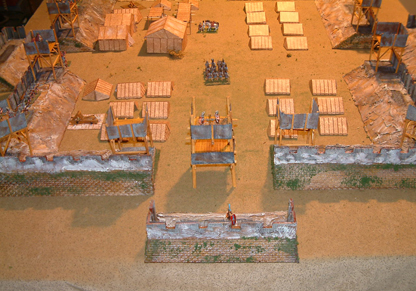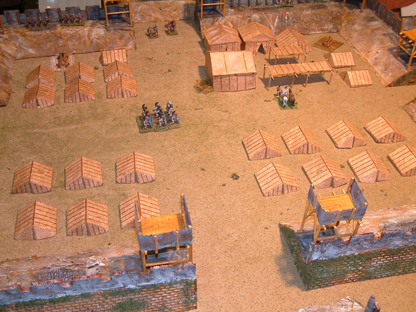Quick Links

Titles
- Second Edition
- Scenarios Rome
- Scenarios Macedonia
- Hack in the Dark
- Holy Hack
- Homeric Hack
- Knight Hack
- Pike Hack

LMW Works

LMW Titles
- Rally 'Round the Flag
- Santa Anna Rules
- Look Sarge, No Charts
- Sniper!
- Hyperspace Hack
- Wellington Rules
- See All

LMW Titles
Caesar's Legions: The Roman Camp
The Castra A Place of Safety
Outside and Inside The Castra
Here we see the typical gate way with towers. You may ask "Where are the gate?" For marching camps the Romans would not use gates. Instead
each gate would have a detachment assigned to guard the gate ways. In case of attack the detachment would stand in the gate way creating a human gate.. Now in a
winter camp under siege as we read in Caesar's Commentaries, the gate ways could be blocked up with portable fences or completely blocked up with earth or logs. In any case there is a part of the gate defenses we have not examined. That is the revelin or tulmus. This is a small wall erected directly in front of the gate way. This was identical to the rampart walls, just lower in height. This could be free standing or be L shaped running directly from one side of the rampart or another. In the former, the gateway would have two points of entrance and exit. In this last case the tulmus would provide only one entrance way, being either on the right or left of the actual rampart portal.

Finally we come to the interior of the camp. You will notice that the gates are points of entrance that mirror one another. These points of entry would open to interior roads which could be paved or graveled. There would be two roads which intersect inside the castra. At the point of intersection would be the headquarters of the units. This was called the praetorium. The praetorium would have tents for the senior commander and his staff. Across from the praetorium would be the quaetor's quarters. The quaestor was the supply officer. Along with his tent would be covered areas for supplies and baggage. By each gate might be water troughs used for washing up by returning patrols.


